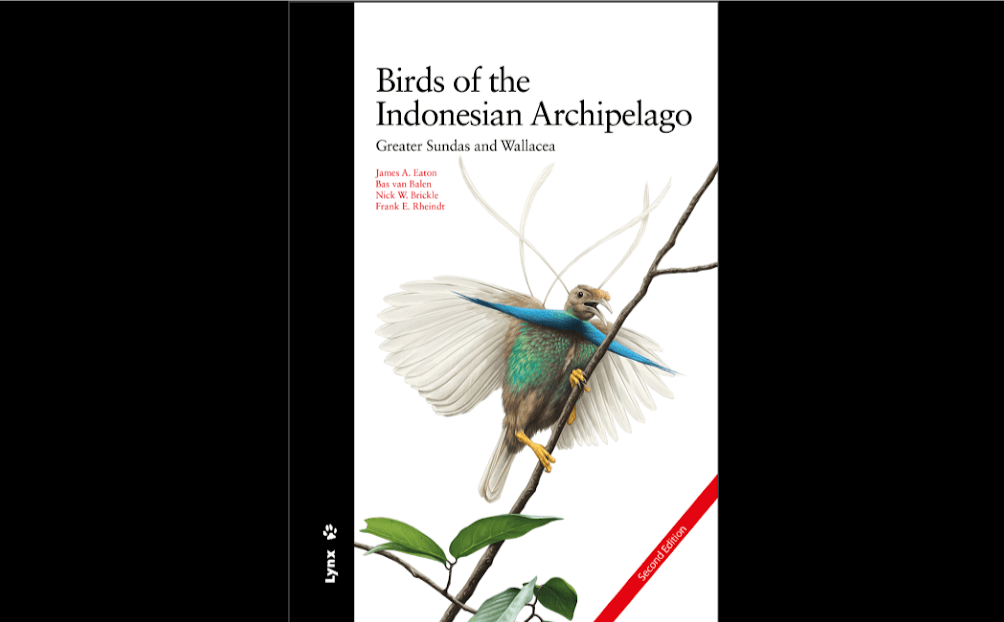
“Birds of the Indonesian Archipelago: Greater Sundas and Wallacea” by James A. Eaton, Bas van Balen, Nick W. Brickle and Frank E. Rheindt is a big book. Or should I say a great book? Or both?
Its dimensions are 16 × 23 cm / 6.3 x 9.1 in (that odd black stripe on the front cover makes it appear even larger in photos), but for a tropical field guide weighs rather moderate 1.2 kg / 2.6 lbs. Before you question how moderate 1.2 kg could be, do keep in mind that this guide covers 4,400 km / 2,750 mi of the Earth’s circumference, or 11% of the length of the Equator, and describes 13% of global bird diversity. And yet, it easily fits in my reporter’s vest pocket and its splashproof flexi-covers bend around my hip comfortably. 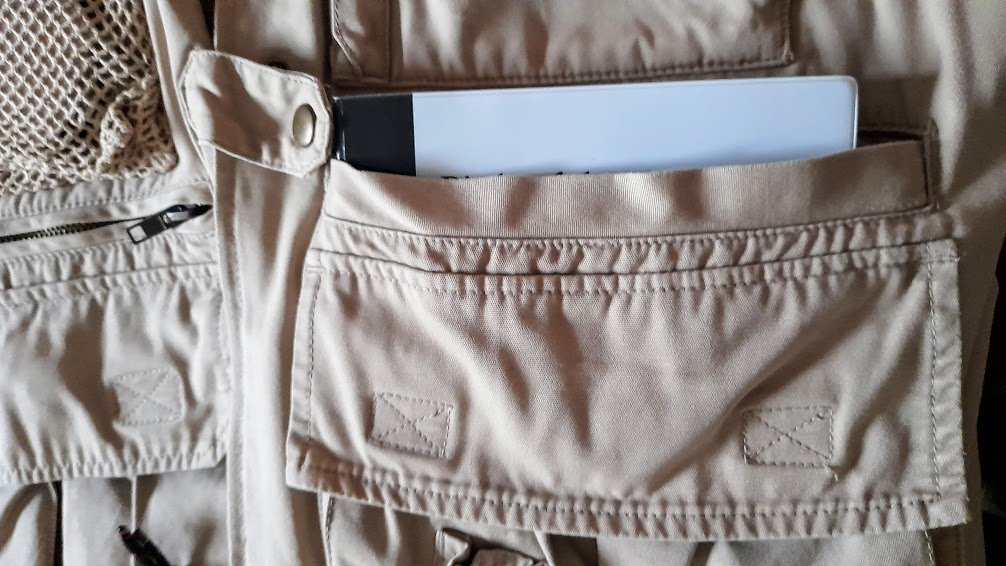
Before the first edition of this guide was published less than 5 years ago, there were no field guides covering this region, only some parts of it (often old, outdated and out of print). Still, how many birders visit this region and could be seen as the target group for this, already a second edition? General birders are visiting the Sabah state in the north of Borneo, while serious listers visit Sulawesi for its 90 endemics. The rest of the region remains fairly undervisited.
Just last year, 5 new bird species and 5 new subspecies were discovered in a few short weeks of fieldwork on the islands of Taliabu, Peleng and Batudaka. Earlier this year, the Black-browed Babbler, widely considered the ‘greatest enigma in Indonesian ornithology’, was rediscovered in the south of Borneo, after more than 172 years. In recent years Indonesia has been competing with the Andes as the region giving rise to the biggest number of undescribed bird species (naturally, all of them endemics).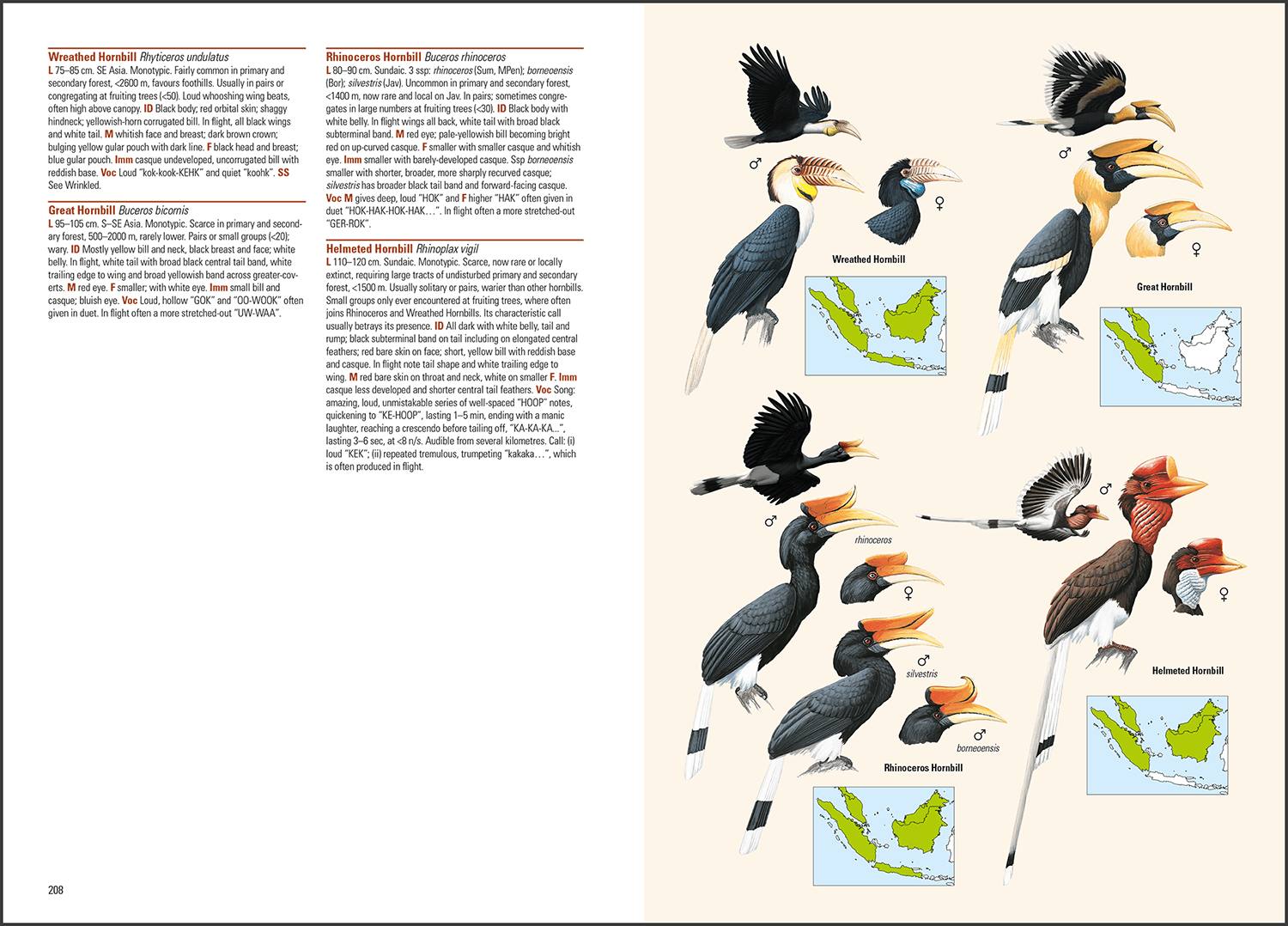
Birds of the Indonesian Archipelago describes all 1,456 bird species (39 species more than in the first edition) within 107 bird families known to occur in the region, including 628 endemics (27 endemics more than in the 1st edition) and 10 species yet to be formally described (down from 18 in the 1st edition). It is important to note that all subspecies are described in detail. Taxonomy follows an integrative approach based on bioacoustics, genomics and morphology, often based on the authors’ own peer-reviewed systematic work in the region. Species accounts have been moved so that similar and/or regional species are on the same page, allowing for easier comparisons and less time spent flicking between pages. And, yes, the enigmatic Black-browed Babbler is described at page 362.
But since Indonesia has more than 1,700 bird species (and that many islands, too), why is this guide dealing only with 1,400? Do not make the same mistake I did – read the title carefully: the Indonesian Archipelago, not Indonesia as a country. The same publisher, Lynx Edicions, has already covered New Guinea region (943 species, including the total of 456 endemics), encompassing Indonesian West Papua (also the West Papuan Islands, Geelvink Bay Islands and Aru Islands) in “Birds of New Guinea – including Bismarck Archipelago and Bougainville” (2017).
Hence, Birds of the Indonesian Archipelago does not deal with New Guinea, but includes East Timor, Brunei, the Malaysian states of Sabah and Sarawak, as well as most of the territory of the Republic of Indonesia: the biogeographic regions of the Greater Sundas (Sumatra, Borneo, Java and Bali) and Wallacea (Sulawesi, the Moluccas and the Lesser Sundas), plus all satellite islands. 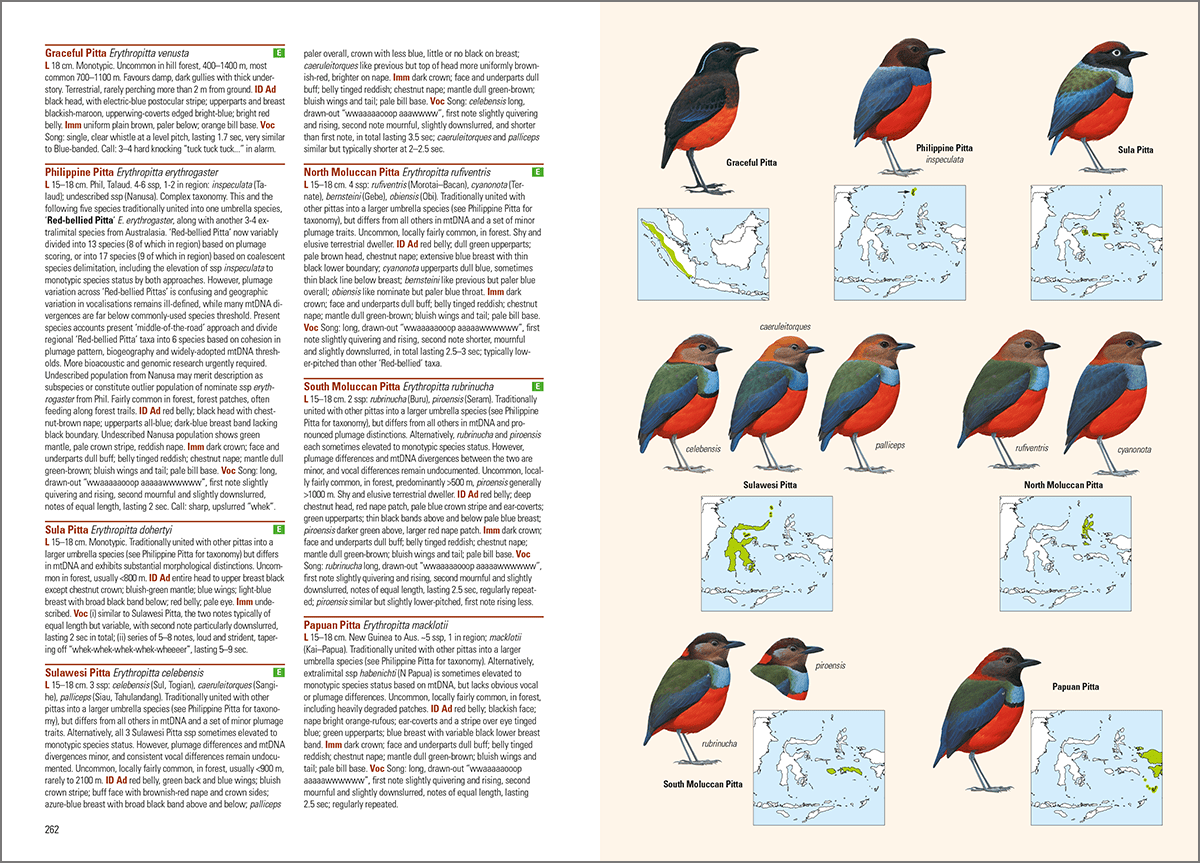
The inner covers are adorned with a map of the region covered. The peninsular Malaysia is not covered, yet it lies within the distribution maps and the bird ranges are depicted in it, too, but only of the species living within the Indonesian Archipelago and not those from the Asian mainland exclusively.
Birds of the Indonesian Archipelago has managed to squeeze a lot in only 536 pages (40 more than the 1st edition), but by sacrificing the font size to being uncomfortably small.
The Introduction deals with something unusual for bird guides – geology of the region and the sea level fluctuations from glacial minima to maxima, also topography, climate and habitats (including lowland tropical rainforests, lowland peat swamp forests, sub-montane and montane forests, deciduous forests, heath forests, grasslands, mangroves, freshwater habitats, farmlands and plantations, and the seas). The main conservation issues are habitat loss, hunting and wildlife trade. A “brief” overview of the history of ornithological exploration spans a good three and a half pages of rather informative and inspirational reading.
Texts in detailed species accounts, covering status, taxonomy, habitat and behaviour, all plumage variations, vocalisations and similar species, may be as concise as six lines only, but sometimes longer than half of a page.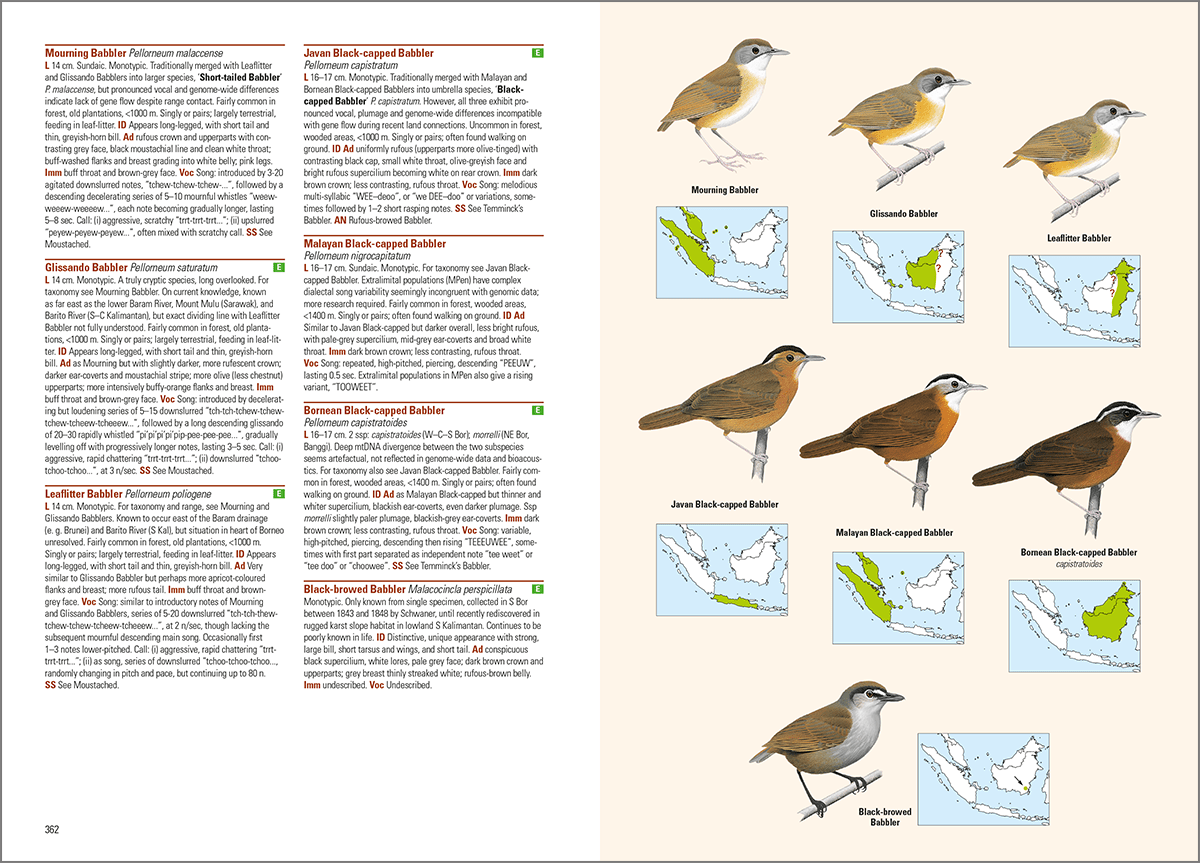
The enigmatic Black-browed Babbler is described at page 362
Most of the 2,800 illustrations are from the Handbook of the Birds of the World, with nearly 500 redrawn and 325 entirely new figures drawn specifically for this guide. They cover all species and distinctive subspecies, non-passerines in flight, males and females, immatures and non-breeding plumages. Illustrations are of a highest standard, meticulously detailed and with a great amount of control of colours during the printing process. While there were 28 artists, you may be forgiven for the impression that there could be only two or three. Some groups, for example shorebird illustrations, tend to be on a smallish side, probably due to the number of various plumages, plus flight paintings per plate.
Despite the species being mapped with improved accuracy through the inclusion of three magnified geographical regions (instead of only one map of the entire region in the 1st edition), I still have a problem with maps. Or with the map layout within some plates, to be more accurate.
The 1,350 colour-coded range maps are positioned within the plates, allowing for longer textual descriptions, and it works well where every species has its distribution map. But in quite a few plates, for example, these storks, vagrants get no map. Here, there are six species described, yet only four maps – and now try to visually assign which map relates to which species?! 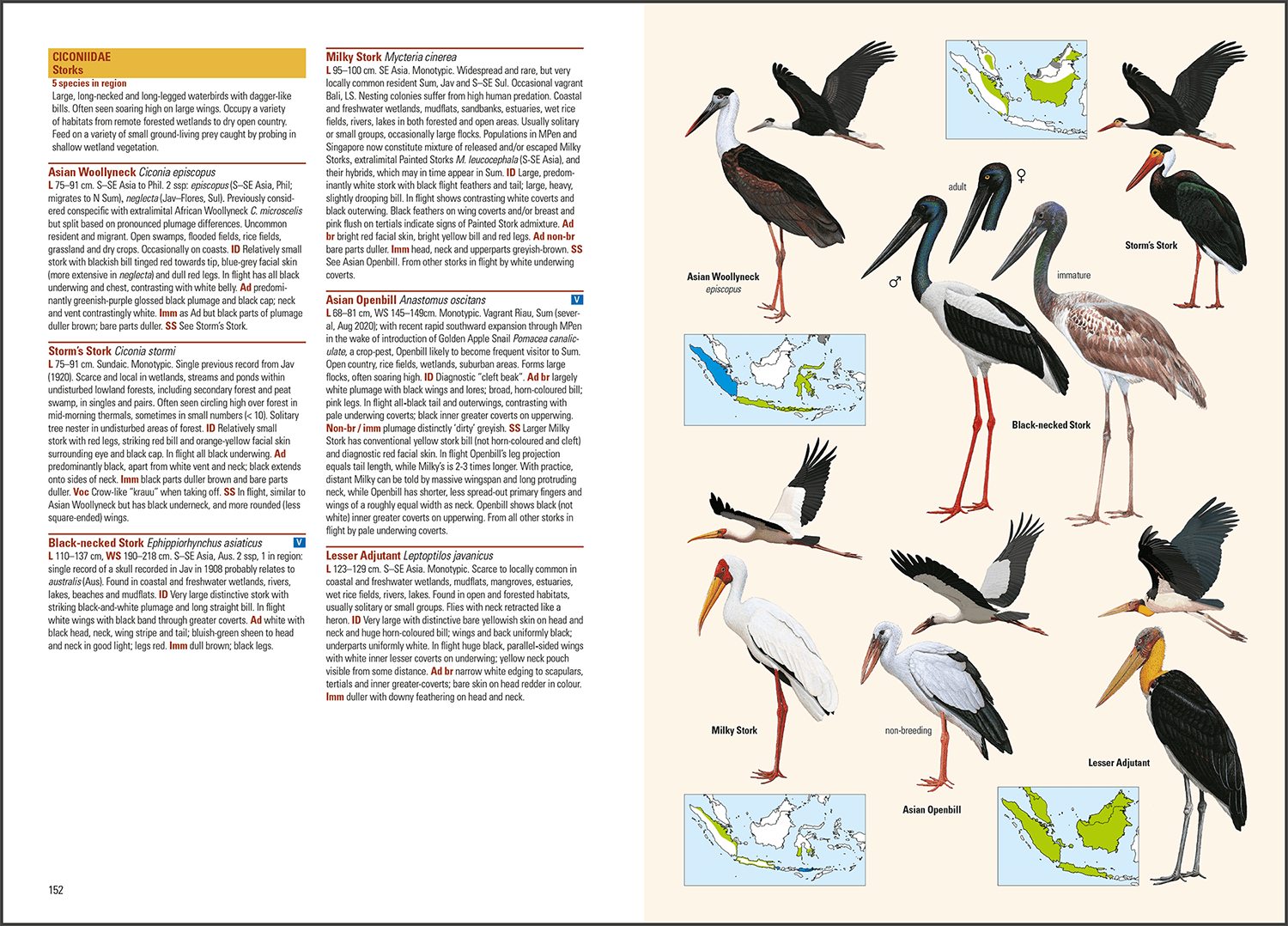
The upper map could relate to either Black-necked or Storm’s Stork, while the lower right may belong to Asian Openbill or Lesser Adjutant. In order to assign them to relevant species, you must check the text to discover which species are rare or vagrant – practically the descriptions of all six species. Soon, you will notice the letter “V” for vagrant (as well as “E” for endemics), but you still need to check the texts to be sure. The same situation repeats itself in more plates, where a discrete arrow at the corner of each map could have solved the issue.
The guide ends with a bibliography, a somewhat odd bird index, as well as a list of Indonesian Bahasa language bird names (it is a pity they are not within the main textual descriptions). The bird index lumps both English and scientific names into the same body of text, but while English names follow logical Sparrow, Eurasian Tree, the scientific names follow a surprising montanus, Passer sequence. 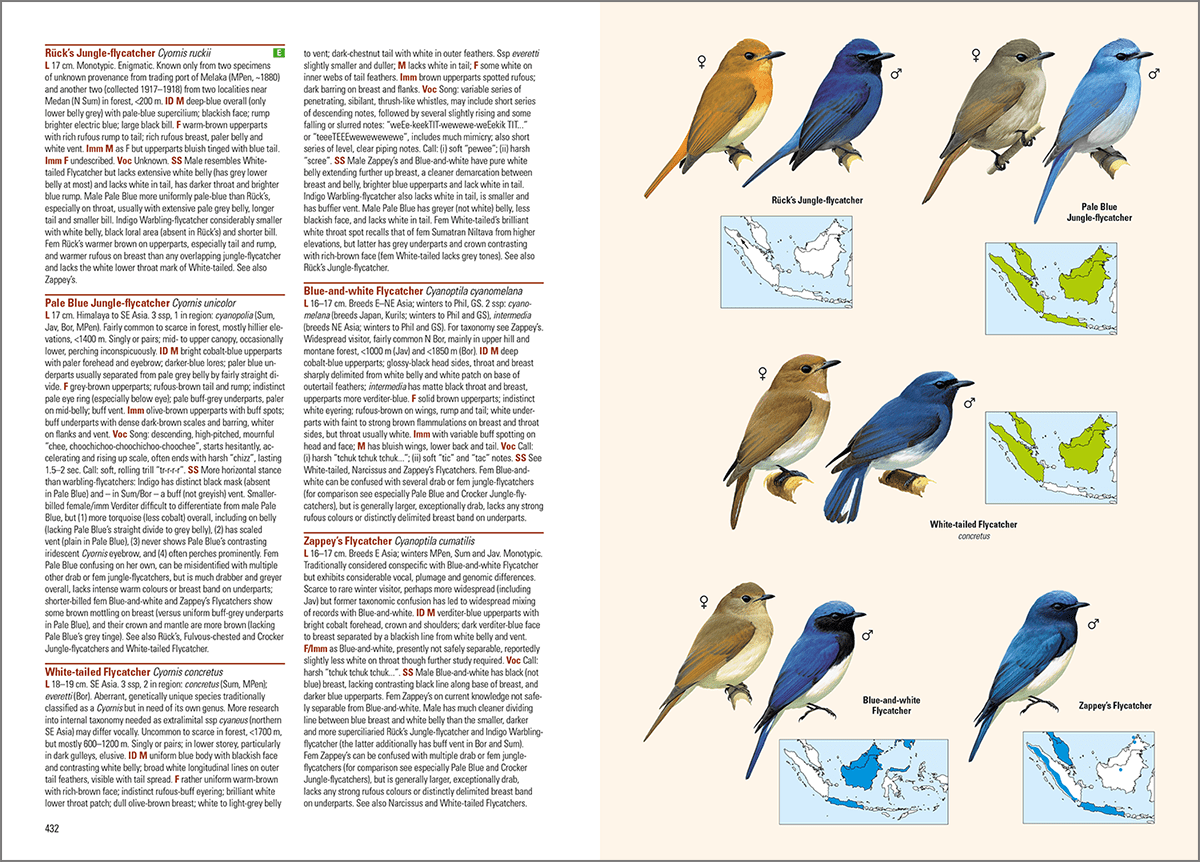
The first author, James A. Eaton, is a co-founder and guide for Birdtour Asia, and has been leading and pioneering birdwatching tours throughout the region since 2005. Bas van Balen has been active in Indonesia ever since his two years of student fieldwork in West Java in 1979-81; freelance ornithologist and consultant for a large number of international and local conservation NGOs and universities throughout Indonesia. Nick W. Brickle is a long-time Indonesia resident, birdwatcher and conservationist from 1992 onwards. Frank E. Rheindt is a field ornithologist, former guide and currently Associate Professor and Dean’s Chair at the National University of Singapore, with a research focus on avian phylogenetics and conservation genetics.
If you are visiting Borneo alone, you may choose from Birds of the Indonesian Archipelago or two other field guides devoted specifically to this mecca of Asian birding. But for the rest of the Indonesian Archipelago region, this isn’t just an excellent bird guide, it is also the only 21st century field guide in existence.
Birds of the Indonesian Archipelago: Greater Sundas and Wallacea
By: James A Eaton, Bas van Balen, Nick W Brickle, Frank E Rheindt
536 pages, 2800+ colour illustrations, 1350 colour-coded distribution maps
Publisher: Lynx Edicions
ISBN 978-84-16728-44-2 Flexi-cover
978-84-16728-43-5 Hardback
Edition 2
Published in February 2021













Interesting that they felt the need for a second edition so soon after the first, http://www.10000birds.com/birds-of-the-indonesian-archipelago-greater-sundas-and-wallacea-a-field-guide-review.htm
Some fascinating facts and what an extraordinary place and even more extraordinary list of birds!
Great review, well done ?
Thanks, Geoff